French schools: Once upon a time…

It is impossible to discuss French schools without mentioning la rentrée. This is a magical word in the French language, and a special time in French life. La rentrée is when tanned vacationers go back to work, government members go back to whatever it is they do for France, members of trade unions go back to planning demonstrations and strikes (scheduled, like clockwork, throughout the fall.) It is also the week children go back to school. As a child growing up in France, I used to love la rentrée.
There was so much excitement in the air as my mom, my brother and I went to the local store to buy our school supplies. My favorite part was coming home with new notebooks (les cahiers,) new pencils and pens (les crayons, les stylos,) and, when I was lucky, a new school bag (le cartable.) I still remember the delicious smell of new stationery and leather.
 |
| The [very French] leather “cartable” (school bag) Robert Doisneau “Cartable Neuf” – 1956 |
 |
| Times change but French school children still love their “cartable,” carried by hand, or on their back |
Looking back, I realize that not everyone in French schools was as enthusiastic about la rentrée as I was. My mother was no doubt relieved to get some of her life back. As a stay-at-home mom (and a dedicated one at that,) she spent all of her free time with us. We did not go to summer camp and spent hours playing with the neighborhood kids. There were adventures. There were picnics and fun-filled afternoons. There were fights. Good times. Still, Maman must have dreaded those shopping trips to the store to purchase new clothes and school supplies. My brother did not much care for la rentrée either. He did not care for school, period. We were different, as siblings often are. I was a good student. A professional student, according to my family. I prefer to think of myself as a a lifelong student. 🙂
I have a story to tell today, about a delightful surprise that fell into my lap in the most unexpected place this summer {FGIS note: blogpost originally published in 2011.} I dedicate this story to Education, the people who love it and fight for it. A special thought for French schools. Imperfect, criticized, constantly evolving, the French school system was founded by visionary men, and is based on strong core principles. I never set a foot in a private school, and neither my parents – or I – ever had to pay more than a few hundred dollars per year for my higher education while I studied in France. To everyone in my family, the French public school system seemed good enough, and it was.
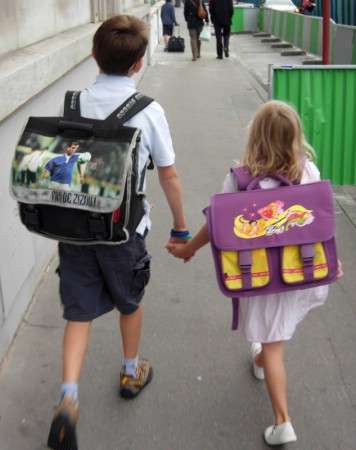 |
| This could have been Le Brother and me, on the way to our new school (our family moved a lot.) |
Last July, on our way down to Spain, we stopped in Carcassonne, in Southern France. The big draw was the famously well-preserved medieval city. It was so crowded within the old walls that we left and did not return until the evening. Scratch that. The rest of the group left and went back to the hotel. I stayed behind and braved the crowds to explore Carcassonne’s medieval streets. After all, the city was packed during medieval times. You can see it on old pictures. At the end of a small street, I noticed an old building behind a stone wall. It looked like a school. Carcassonne is such a busy, touristy place. I was surprised to find it there. The school, it turns out, closed many years ago, but a dedicated volunteer and former teacher opened a museum in the building. Le Musée de l’Ecole, a museum dedicated to French schools. It is a wonderful place to remember what school was like in the old days for our parents and the generations that preceded them, a great place to understand education in France, and how it evolved over time. The museum focused on school life during the 3rd and 4th French Republics, (roughly from 1875 to 1958 when Charles de Gaulle was elected President of the current 5th French Republic.) As I walked through the metal gate, and off the cobbled street, memories flooded back. Here, I was, in the cour de récréation (playground) of my old elementary school. The hopscotch game (la marelle) still traced on the ground. I looked at le préau (covered playground) and remembered chatting there with my girlfriends on rainy days.
I entered. A charming volunteer greeted me and informed me: “Pas de photo, s’il vous plaît.” No pictures. Dommage. Fortunately, I took copious notes during my visit and found pictures online to help me describe that incredible place. Imagine five rooms filled with artifacts, photos, posters, old geography maps (still showcasing the French colonial empire) and two full-scale reconstructions of classrooms dating back to the late 19th and early 20th century. There was an extensive collection of old textbooks (les manuels scolaires,) all over 100 years old. Brocante fans and collectors of used books would have loved the opportunity to get their hands on these!
There were official letters written to the local instituteur (school teacher) by politicians, such as French socialist leader Jean-Jaurès (1859-1914,) a former teacher himself (“The children you have been entrusted with are French. They must know France, its geography, and its history: its body and its soul.“) These documents reflected the involvement of French leaders in education as early as the late 18th century. Teacher training and government support of popular education were a core issue of the French Revolution in 1789. In the following decades, French political leaders including Napoleon, got involved. Then Jules Ferry came along. A lawyer and Minister of Public Instruction in the 1880s, he is widely credited for creating the modern Republican school in France (l’Ecole Républicaine.)
 |
| Jules Ferry (1832-1893) |
Until Jules Ferry, primary and secondary education were two separate entities in French schools. The Catholic church was involved in elementary education at the local level. In the wake of the industrial revolution, Ferry and other leaders realized that there would be a growing need for a skilled workforce. The work day was changing. In a time of political instability, qualified workers would help make the 3rd Republic stronger. The role of French schools would be to educate and train future French citizens. The Jules Ferry Laws revolutionized French education in the late 1880s:
– Mandatory instruction for all French children from 6 to 12 years old (a law passed in 1959 made school mandatory until the age of 16.)
– Free instruction, including all textbooks.
– Secular education (Education laïque).
As a direct result of the Jules Ferry laws, the teaching of civics and ethics replaced daily catechism instruction in French schools. I remember those morning ethics lessons, (“leçons de morale“) and the posters on the classroom walls. Many were displayed at the Carcassonne Museum of School.
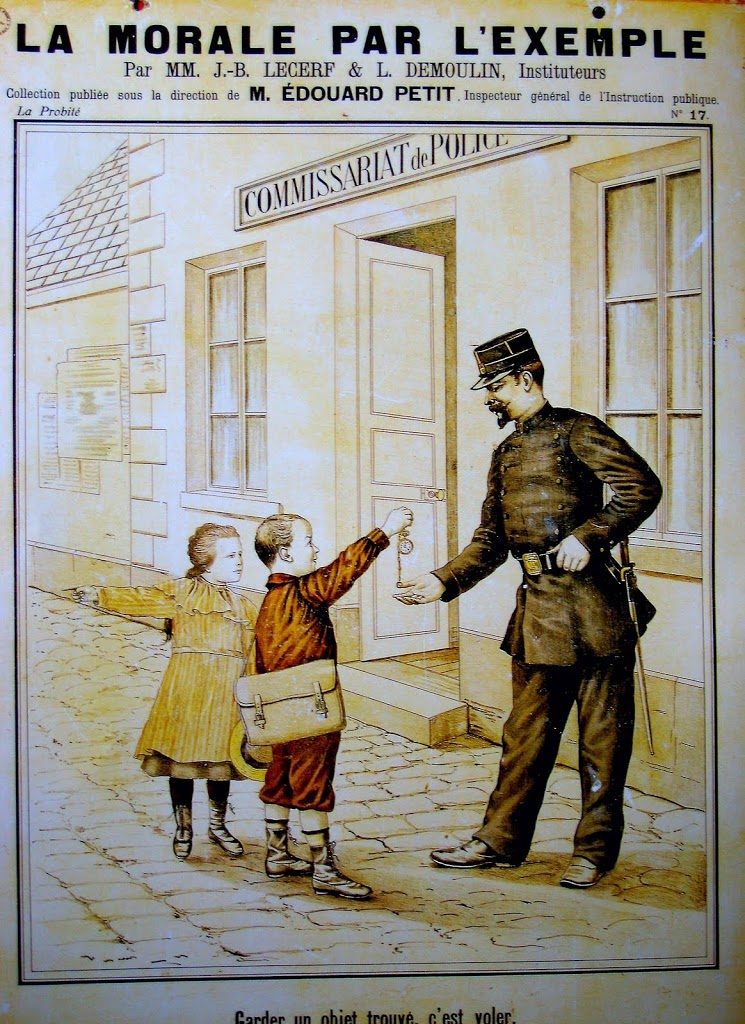 |
| “Garder un objet trouvé, c’est voler” (Keeping something you have found is stealing) |
Every morning, in French schools, le maître (the teacher) would write a short saying on the blackboard, then comment it for students. A poster at the museum read: “Je serai poli envers tous les membres de ma famille.” (I will be polite to all of my family members.) Another one praised the virtue of hard work: “Les mains noires font manger le pain blanc” (Black hands enable you to eat white bread [representing affluence, prosperity].) Common themes were politeness, honesty, sobriety, cleanliness, respect.
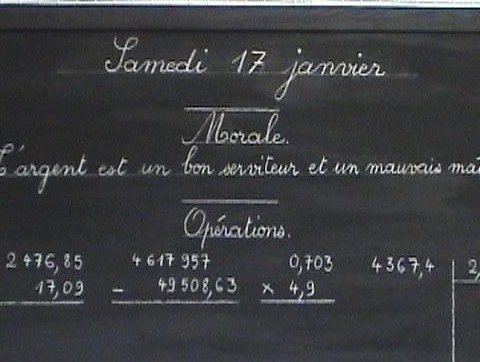 |
| The blackboard welcomed students in the morning |
Jules Ferry placed the responsibility of building and maintaining French school grounds on cities. Until 1919, they paid their teachers directly. Many French villages opened their own school. Sometimes, the school was so small that one dedicated [and respected] instituteur (elementary school teacher) was in charge of teaching several grades. He often lived within the school buildings. This is illustrated in an excellent French documentary, “Etre et Avoir” (To Be and to Have), presented at the Cannes Film Festival in 2002. The movie can be rented in the United States through Netflix, and I highly recommend it.
 |
| A scene from “Etre et Avoir” |
As I was walking through the Museum of School, I realized how different a typical day in a French public school used to be from what my son experiences here in the United States. For one thing, the school day was a lot longer, and it still is, 9:00 to 5:00pm on an average, with a two-hour lunch break. The atmosphere in the classroom was formal. The teacher’s desk stood on a platform, next to the blackboard. The teacher, the authority figure, dominated the students lined up in front of him. He looked stern, in his grey smock.
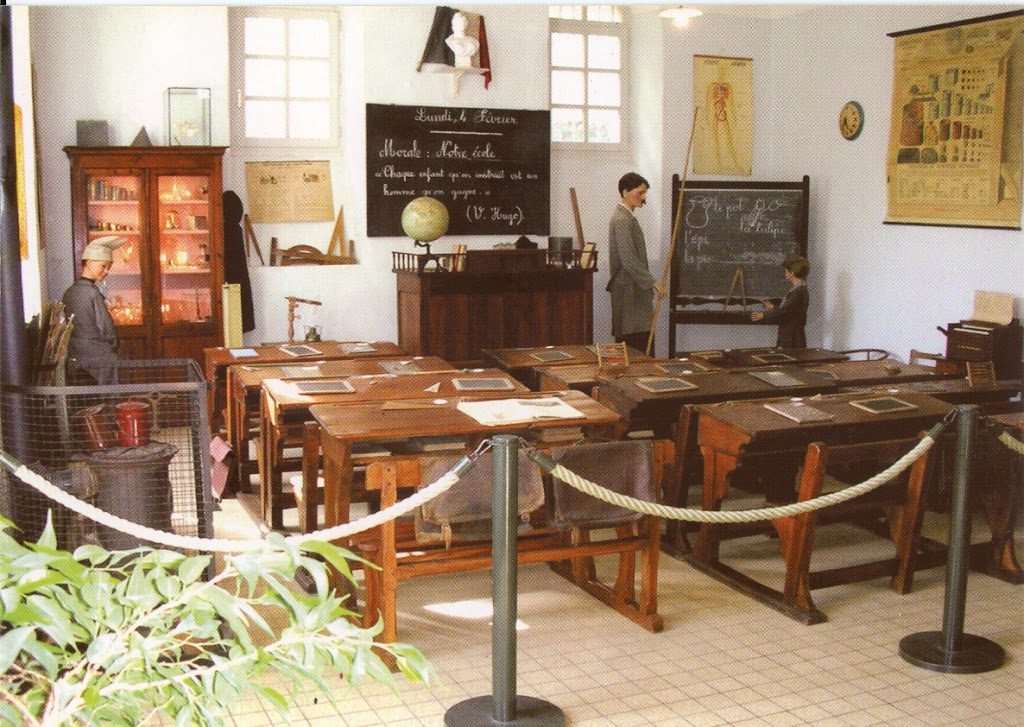 |
| La classe |
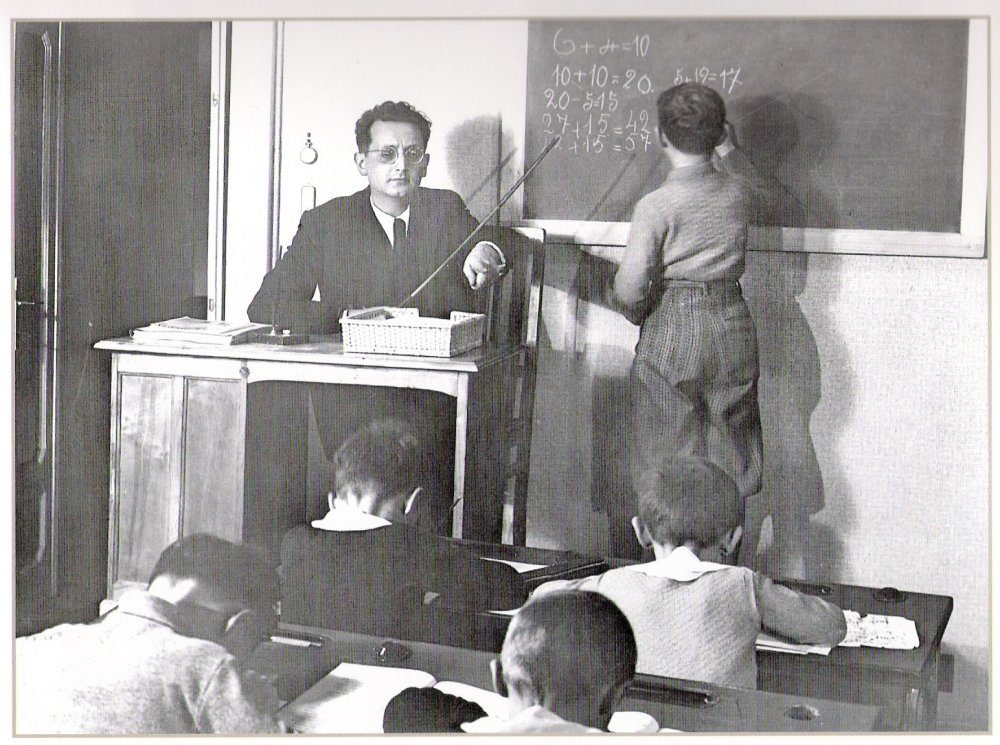 |
| 20th century classroom: I would not have enjoyed learning math with that man! |
Let’s meet an écolier (student) circa 1900.
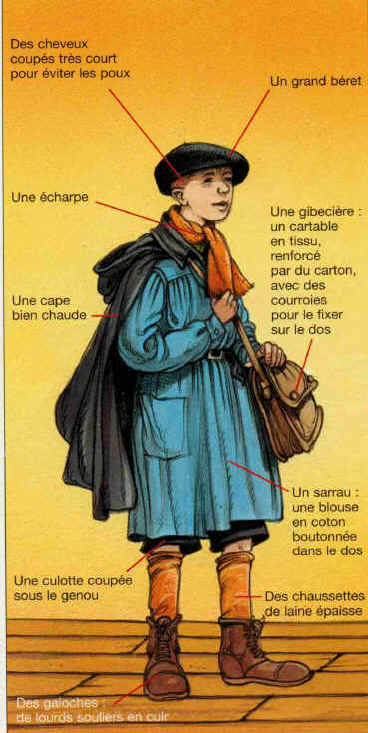
Short hair (to avoid lice.) A large béret. A warm cape and a scarf. La gibecière, (school bag,) worn across the body. Le sarrau (smock) buttoned up in the back. Thick socks. Short pants, cut at knee length. Les Galoches (heavy leather shoes.) What was inside the students’ bag? His school supplies. All textbooks belonged to the school and were loaned to the students. They owned une ardoise (slate) and practiced their spelling and grammar, or did math operations on it, using chalk.

They also wrote on several cahiers (notebooks) with lead pencils first, then, once they “qualified” with un porte-plume (pen holder.) Each student’s wooden desk or pupitre (meticulously polished by the children at the end of each week) included un encrier (small inkwell) filled with purple ink by the teacher or an older student. The students’ fingers were permanently stained by the ink.
 |
| Porte-plume and selection of “plumes” “La Sergent Major” was pointed, and harder to use than “la Gauloise” (shaped as a diamond) |
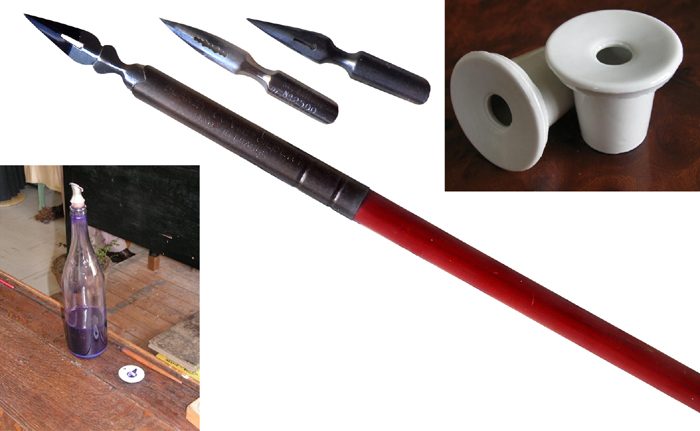 |
| Encriers (inkwells), Porte plume (penholder) and bottle of purple ink |
In France, where aesthetics are everything, students were expected to keep their notebooks immaculate. There was a proper way to hold a pencil or a pen holder, and calligraphy was taught at an early age. When I started 1st grade, my teacher tried to convince me that I had to write with my right hand (I am left-handed.) Lefties had a reputation for having bad hand-writing. I was stubborn and she gave up. That year, I was proud to become the first student in the classroom who switched from a pencil to a penholder I used to write in beautiful purple ink.
 |
| Letters of the alphabet |
While in the United States paper is lined, France has used “la réglure Séyès” since 1892. Do you notice the difference?
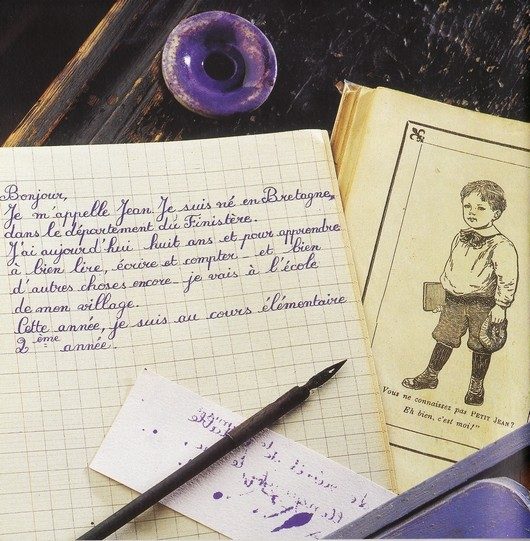 |
| This is what I call a neat notebook! The student is using un buvard (blotting paper) while writing |
At the Museum of School, one of the rooms was a workshop where visitors sat down at small desks and practiced writing in purple ink with a pen holder. I tried and realized I was très rouillée (very rusty.)
School at “la Communale” (public school) was hard work. Typical subjects included: history, geography, math, grammar, spelling, writing, calligraphy, poem recitation, vocabulary, science, art, choir. Les Devoirs (homework) had to be completed in a special notebook. Memorization played an important role in French schools. Hardworking, attentive and respectful students were rewarded with les bons points and les images (picture cards including special messages.) Some had quite the collection by the end of the school year.
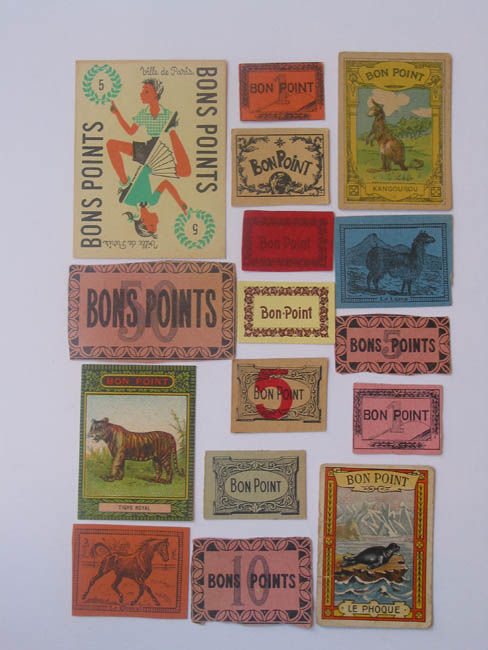 |
| Collection of “bons points” |
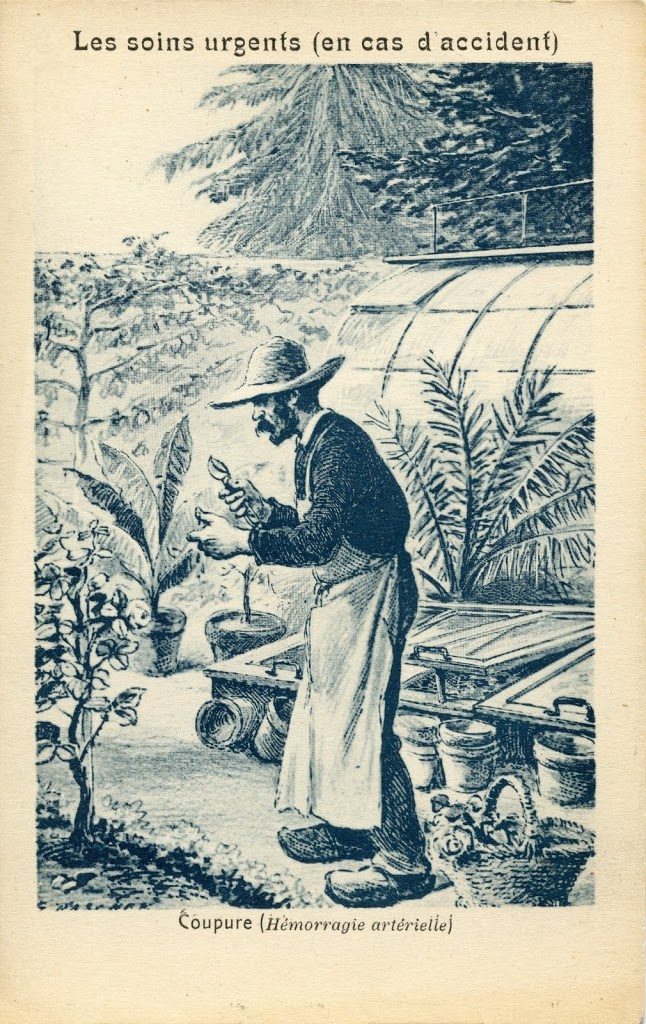 |
| “Image” (picture card): This one shows what to do in case of a medical emergency (a cut) |
Bad students (les cancres), however, were in for a lot of trouble. Physical punishment was prohibited, theoretically. Public humiliation was not. Punishment for poor work or poor behavior included standing in the corner, back turned on your classmates, with your hands on your head, sitting under the teacher’s desk, wearing a paper or fabric hat known as le bonnet d’âne (dunce’s cap) during the school day.
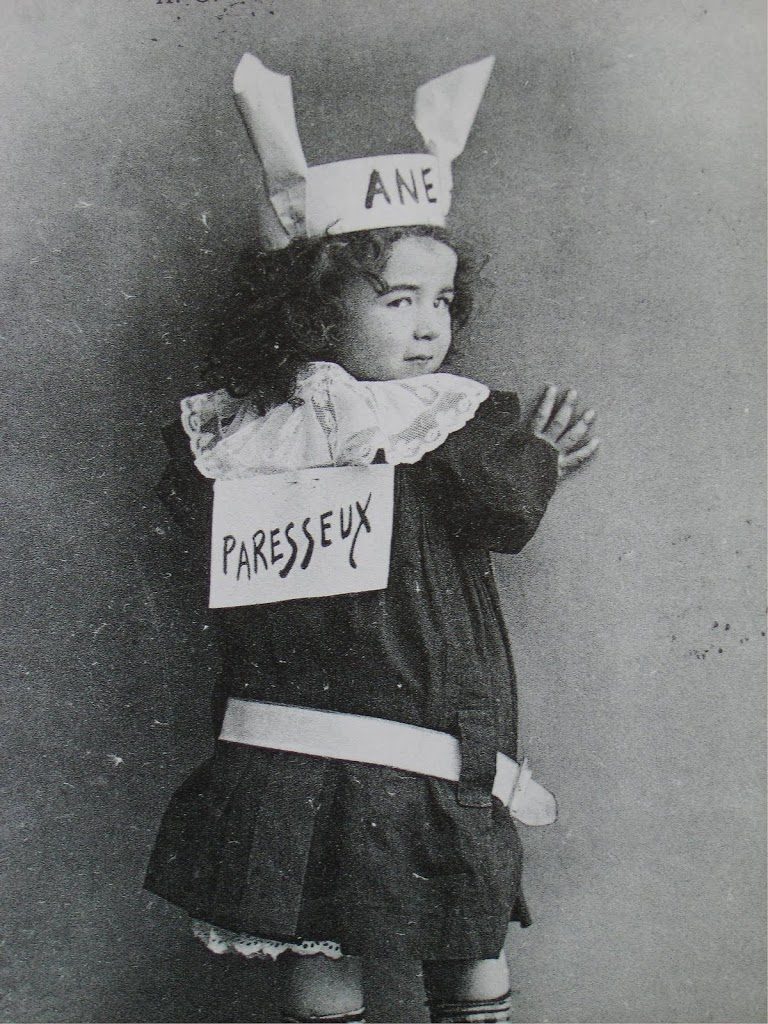 |
| Student wearing “le bonnet d’âne”. The sign reads: “Paresseux” (lazy) |
Horrified yet?
It is tempting to label the French school system inhumane, or at the very least rigorous. Let’s just remember that it was not unusual then for le maître d’école (teacher) to deal with 40 or 50 kids in his classroom. Even though the infamous bonnet d’âne is long gone, most of the students who went through the French education system have memories of being rebuffed (and sometimes humiliated) in front of other students. We all lived in the fear of making mistakes. French schools are not for the faint of heart. I am a strong believer that what does not kill you makes you stronger. The French are notoriously rebellious and don’t hesitate to break rules. They can be very creative when they do so. Is it really that surprising? A blogger friend of mine recently made some very interesting comments about the French and American approach to bureaucracy here.
Do not feel too sorry for our French écoliers of yore. Boys and girls also had fun at school. La récréation (recess) was everyone’s favorite time of day, of course. Boys played with marbles (le jeu de billes). Other popular games included la toupie and le jeu des osselets.
 |
| La toupie |
 |
| Les Osselets |
Girls enjoyed la marelle (hopscotch) and la corde à sauter (jumprope.)
 |
| La marelle: from la Terre (Earth) to le Ciel (sky) |
The last room at the Museum of School was the one that surprised me the most. It showcased a special exhibit about les bataillons scolaires (school battalions.) There were a few other French visitors in that room, and they all looked equally puzzled. We were reminded that following the defeat of 1870 (Treaty of Frankfurt, 1871) France had paid a hefty war indemnity to Germany, and had surrendered Alsace and part of the Lorraine, thus losing 1.6 million inhabitants. The reconquest of the “lost provinces” became a national obsession, culminating in France’s involvement in WW1 in 1914.
The government of the 3rd Republic decided to use elementary schools to train future patriots, young citizens who would, one day, serve the French Republic. Patriotic messages were included in most subjects taught in schools, more noticeably history, geography, and daily ethics and civics lessons (see above.) The importance of respect (of the Law, authority, French institutions) and love of la patrie (the Motherland) were drilled into young brains.
In 1880, physical education (gymnastics) became mandatory in French schools. By 1882, the first bataillons scolaires (school battalions) were created all over France. Even though students had to be 12 years old to participate, younger children could also join in the practice sessions. Battalion members were trained after school hours, using either real rifles or wooden ones. They were provided with uniforms. Training culminated on the day of the July 14th parade (Bastille Day) when local school battalions proudly marched through town.
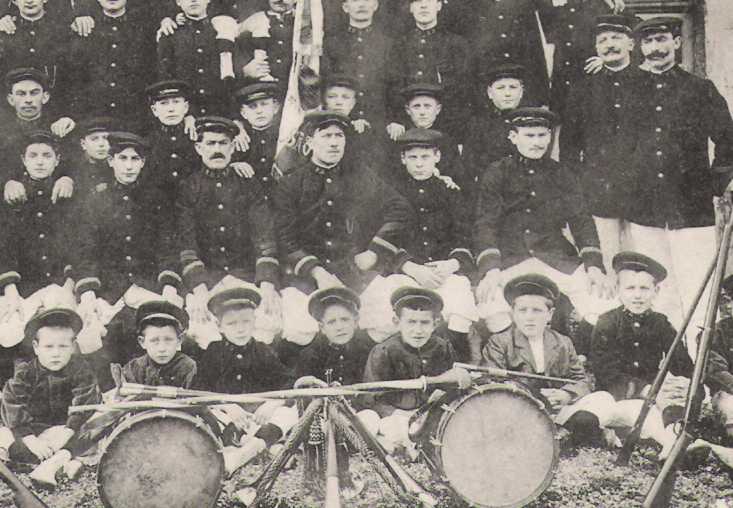 |
| Bataillon scolaire circa 1885 |
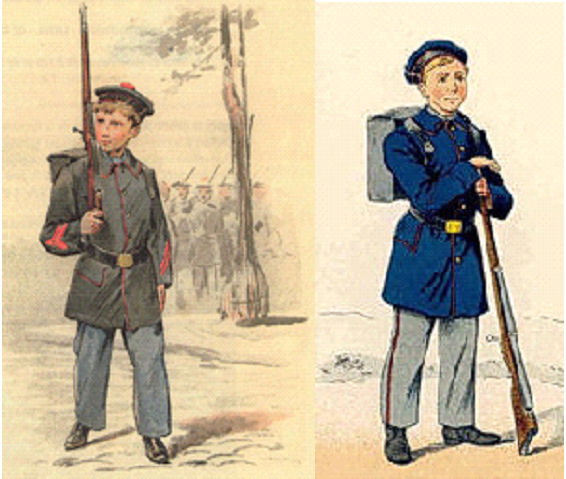 |
| Uniforms |
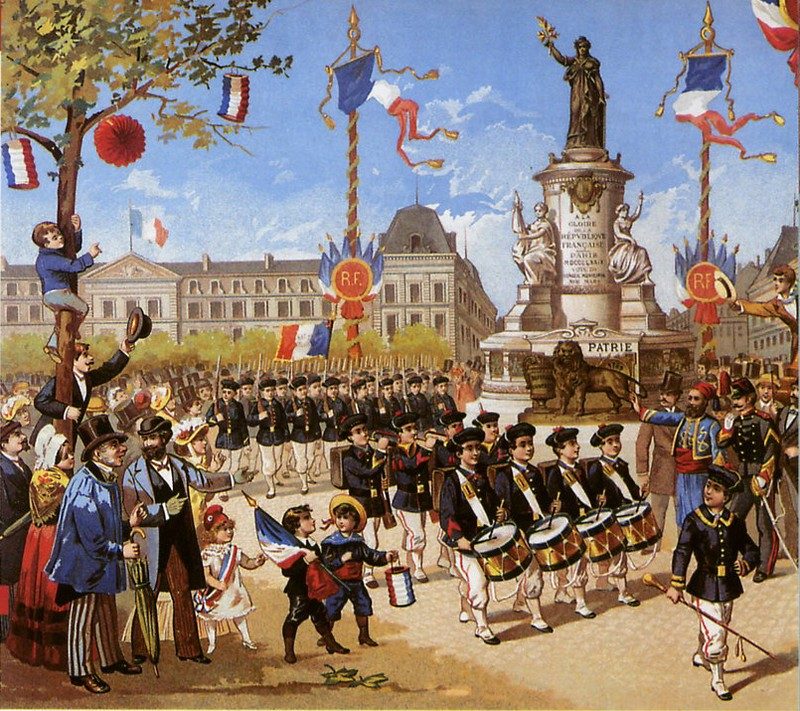 |
| Défilé du 14 juillet (July 14th parade) |
After a few years, enthusiasm for the movement dwindled. Criticism of the battalions grew louder. Parents and school teachers voiced their concerns. Discipline was too rigid. The patriotic message was not getting across, and students were mainly interested in wearing the beautiful uniforms and handling the guns. The cost of running local programs became too high for a lot of municipalities. By 1892, les bataillons scolaires disappeared for good and were officially replaced in all primary schools by twice weekly PE classes.
Unfortunately, l’esprit revanchard (desire for revenge) and intense patriotism fostered both by the French and the German governments at the turn of the century would only be exacerbated until WW1, the Great War.
Before I left Carcassonne’s Museum of School, I shuddered when I realized that the school children I was seeing on the old faded pictures would become les poilus, (the hairy ones,) the French infantry soldiers during WW1. Many of them were peasants and wore a beard or a mustache, hence their nickname. They were famous for their bravery and endurance and (quelle surprise!) their rebellious spirit. More than 1.4 million poilus would die, during what remains one of the deadliest conflicts in history. They were buried near battlefields and their bodies often could not be brought home. They are remembered all over France thanks to the ubiquitous Monuments aux Morts (war memorials,) listing fathers, sons, cousins and friends killed during the conflict. It seems every French city/town/village has one.
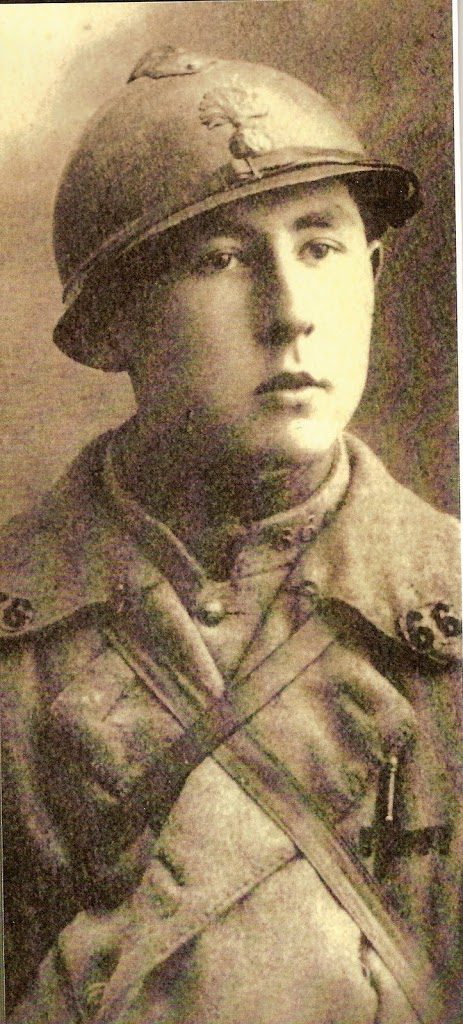 |
| Young Poilu identified as Gabriel le Pord (born in 1899) |
 |
| Un Poilu, having lunch |
 |
| Saint Paul de Vence, August 2011 “Morts pour la Patrie” (they died for France) |
Les Poilus are all gone now, but France has not forgotten them. May they play forever on the school grounds of their childhood.
A bientôt.
Musée de l’Ecole (Museum of School)
3 rue du Plô
La Cité
11000 Carcassonne, France
Open year around, 7 days a week
10:00am-6:00pm
Email: musecole.carca@tele2.fr

Or click a link below to read the next (or previous) post...allons-y !
1 Comments
Leave a Comment
Join la Mailing List
Be the first to read stories and travel tips I don’t share anywhere else!
No spam, ever. That’s a promise. Visit the Privacy Policy.

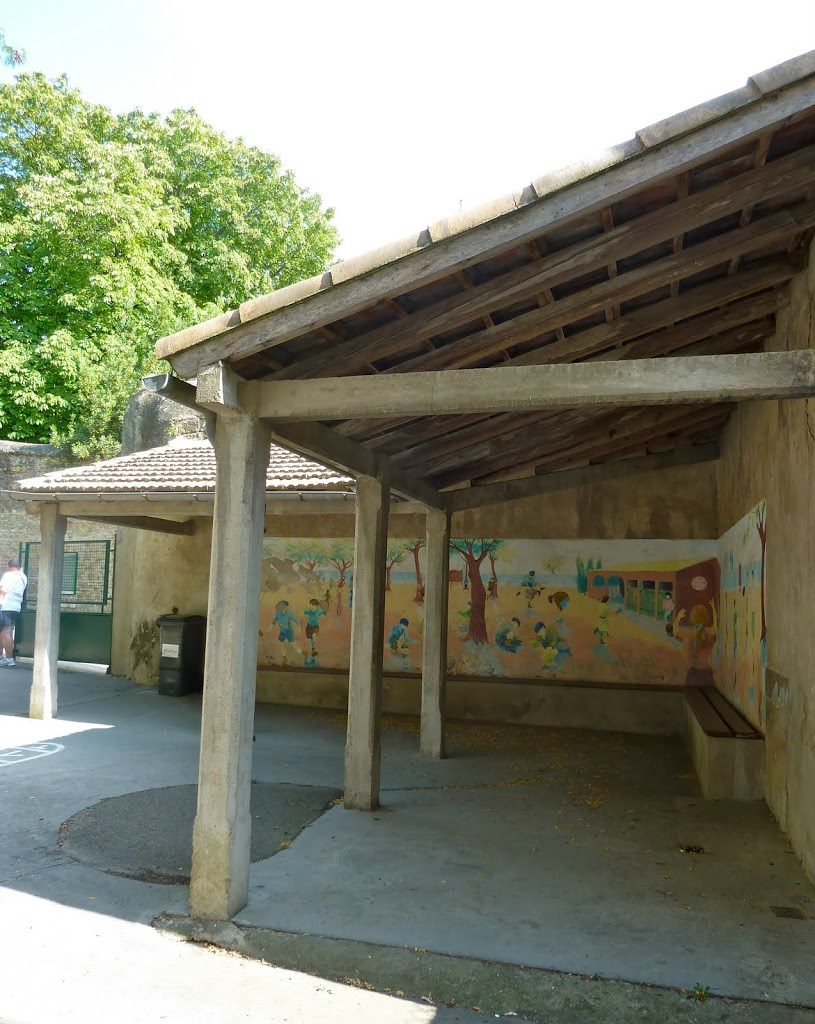


Thank you for this insightful and comprehensive guide to French schools! Your blog provides valuable information for anyone navigating the education system in France. The detailed explanations and personal insights make it a fantastic resource for those seeking to understand and appreciate the unique aspects of French education. Well done!